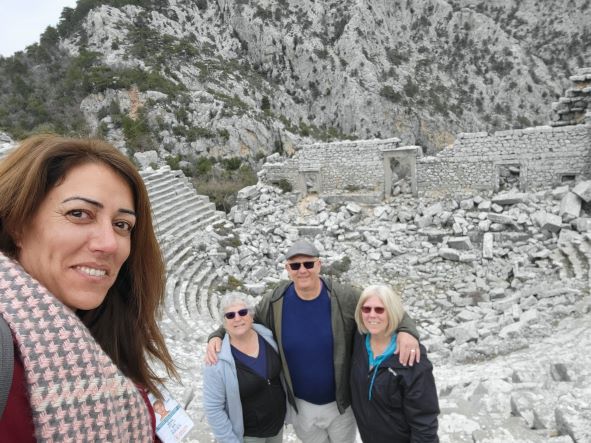We find ourselves heading south today after deciding to bail on Cappadocia; the weather was awful, snow, wind, not the place to be spending any time. We will return in ten days; hopefully, winter will have eased her grip by then. With great disappointment, we lost our guide Meral, for personal reasons. We are provided with a new driver/guide, his name is Ugur; he is from Cappadocia. He has big boots to fill as Meral was exceptional as our guide, she knew what we liked. This post, “Guide To Kızkalesi What Sites You Need To Visit,” is our seventh in a series of posts. Cindy and I are documenting our adventures and visits as we travel across Turkey with ITT Group Turkey. We purchased this Turkey tour package while visiting Pamukkale.
We will be doing a seven-day swing into Eastern Turkey, where we will see sights and destinations that many out-of-country tourists do not travel to. Topping the list would be Mount Neumrut, as the pictures seem to symbolize Eastern Turkey. For now, though, we will be starting in Kızkalesi, a short drive from Mersin on the Mediterranean coast. The weather is already better than what we left in Cappadocia this morning.
A Brief History Of Kızkalesi And Area
The first records date back to the Hittite period, but many findings show as early as the Hellenistic period. Kızkalesi, which came under the rule of Rome in 72 BC, remained under Roman control for 450 years. It showed significant development in olive cultivation during this period and became an olive oil export center. The city was enlarged to the east in the Roman period, and new walls were built in the 4th century AD when the city reached its peak. The Romans, Byzantines, Seljuks, Armenians, French (Kingdom of Cyprus), Karamanli, and Ottomans have all had a part in the history of this region. Driving along many of the roads in the region, you will see ancient ruins; some are but a single structure.
Guide To Kizkalesi Visit Elaiussa Sebaste (map)
The city was founded in the 2nd century BC on a small island. Later the town was moved to the mainland and called Sebaste, which meant “imperial city.” The city flourished after its shores were cleaned of pirates by a Roman emperor in 74 AD. It started to lose its importance in the 3rd century AD. It became a Christian city during the Byzantine period, and many churches were built. In the 6th century AD, the town of Corycos (Kizkalesi), its neighbor, began to flourish; thus, Elaiussa Sebaste was abandoned.
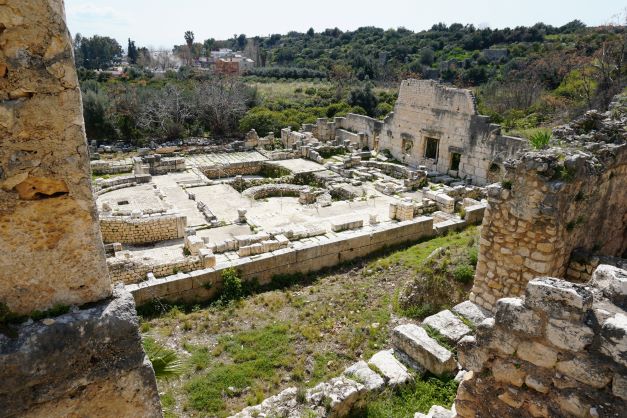
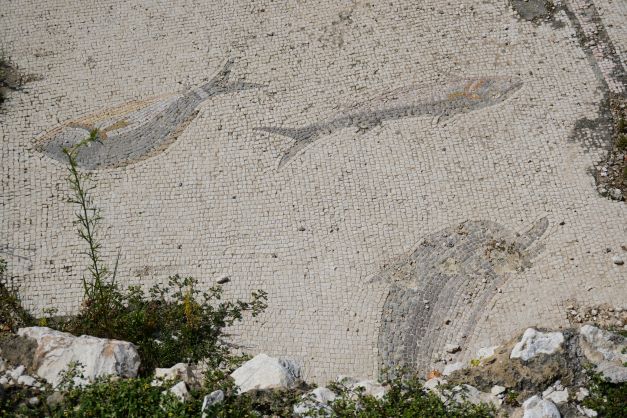

On the opposite side of the road that divides Elaiussa and Sebaste, there is a small theater from the 2nd century AD. Next to the theater, is an Agora surrounded by a wall, which has two lion-shaped monumental fountains at the entrance. There is a large Byzantine church inside the Agora with a beautiful mosaic floor. A pagan temple sits atop a hill overlooking the sea outside of the city, decorated with columns. There is a large Roman bath complex between the temple and the agora. One of the most impressive ruins at Elaiussa Sebaste is its well-preserved necropolis (cemetery). The necropolis is located on a hill to the north of the city. In the vicinity of Elaiussa Sebaste, one can visit other smaller sites with ruins such as in the villages of Hisarinkale, Kabacam, Catioren, Imirzeli, Veyselli, Tabureli, and Okuzlu.
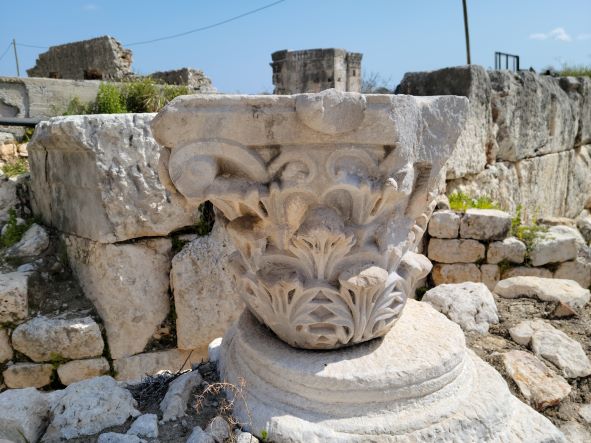
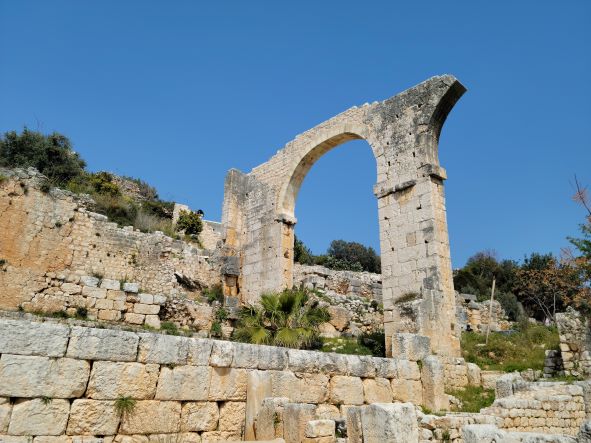
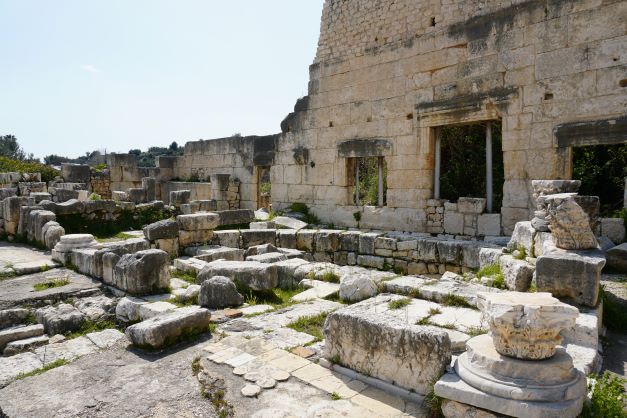
We stopped here at Elaiussa Sebaste; it was on the way to Kızkalesi. There are ruins found along both sides of the road; it is worth stopping and visiting; there is no fee to walk around, and there are signs explaining some parts of the site. We found the ruins interesting, with very impressive fish mosaics on one of the floors. We spent about sixty minutes here wandering around, taking lots of pictures and admiring the sights.
Guide To Kızkalesi Visit Korykos Castle (map)
The earliest records of Korykos are from the Hittite period, although most discoveries date from the Hellenistic age. In Roman times, the city was extended to the east, and new defenses were erected in the 4th century AD when Korykos reached its peak. Korykos’ Christian period is an essential aspect of its history. There are fourteen churches from the 4th to 7th centuries AD preserved in this region. The Armenian Kingdom of Cilicia erected Korykos Castle on previous fortifications in the 12th century. After numerous modifications and rearrangements, the castle took its present form in the 13th century.

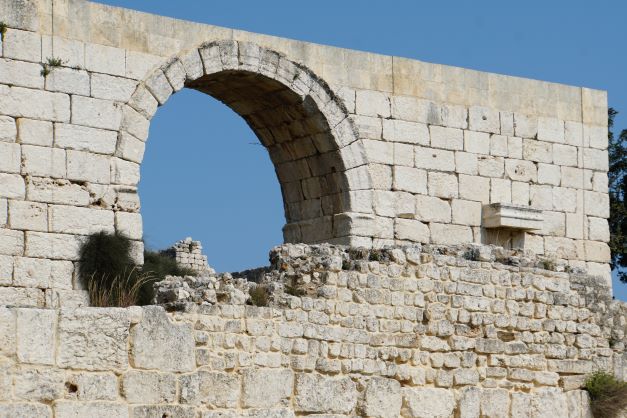
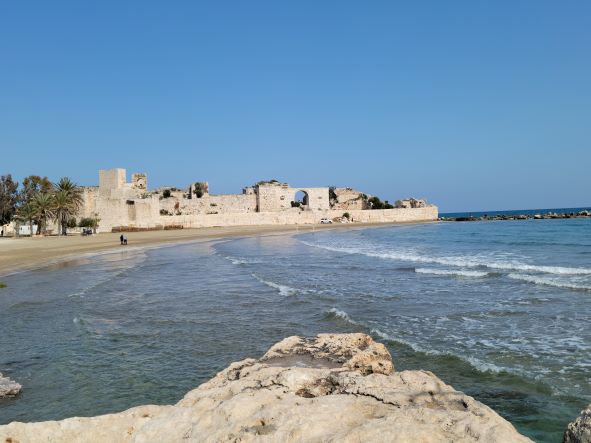
We tried to visit this castle but were told that it was closed, it looked interesting from the outside, just too bad we never got to see it on the inside. The castle is situated on the beach, a short walk from the downtown area.
The legend of Maidens Castle (Kız Kalesi) (map)
The legend of Kız Kalesi is similar to the myth of the Kız Kulesi (Maiden’s Tower) in Istanbul. According to the legend of Kız Kalesi, the King of Kyrkos had a daughter whom he loved very much. He asked a fortune teller to look at his daughter’s future one day. Looking at the girl’s hand, the fortune-teller startled and told the king that a snake would bite her and she would die. The king, who was very upset about this, had a castle built on an island near the coast and settled his daughter there.
A snake hiding in a grape basket sent to the island killed the girl. “Kız” means “Maiden,” and “Kale” means “Castle” in Turkish. The castle took its name from this legend. Although used sporadically throughout the late medieval period, the fortress eventually fell into disrepair. Despite its glorious history, the island remains a puzzling and visually-stunning ruin today and is slowly decaying under the forces of weather and time.
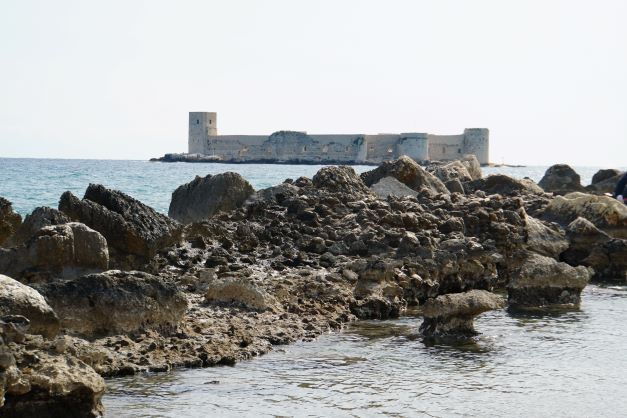

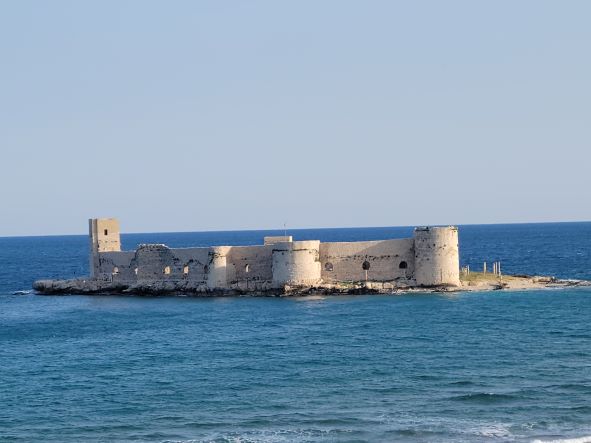
Guide To Kızkalesi Visit Heaven and Hell (Cennet-Cehenem) (map)
Cennet and Cehennem (English: heaven and hell) are the names of two giant sinkholes in the Taurus Mountains. The sinkholes are situated next to each other.
Sinkhole To Heaven
Heaven sinkhole is larger than the Hell sinkhole and is the one you can descend into. A stone staircase makes it’s way down where you will find a church before entering the cave. In a 4-line inscription on the entrance door of the church, it is written that this church was built in the 5th century by a religious person named Paulus, dedicated to the Virgin Mary. It is said that there existed another temple from pagan times at this location.
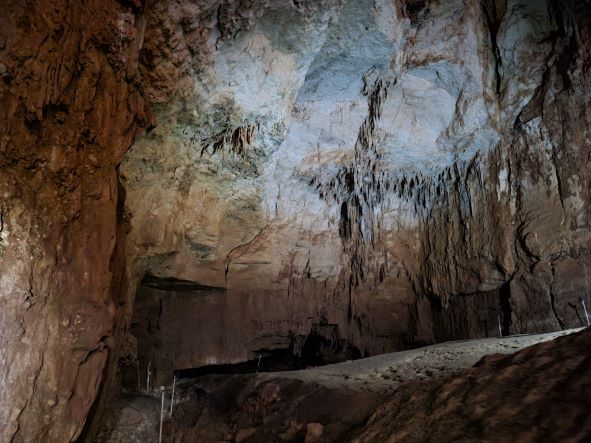
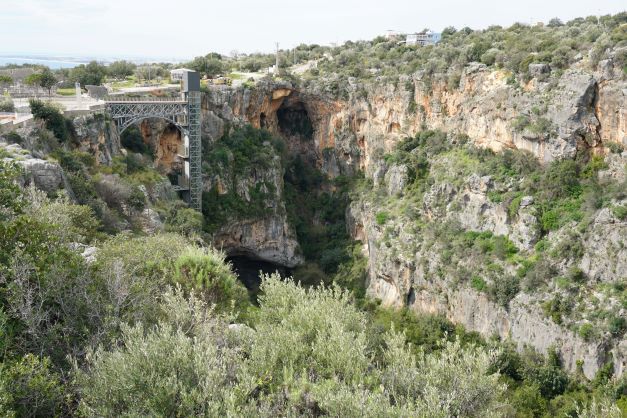
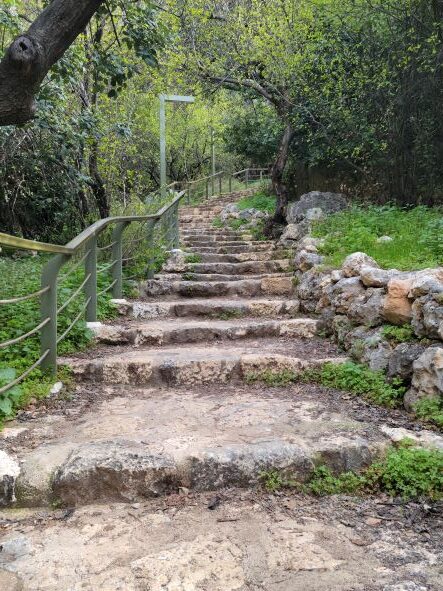
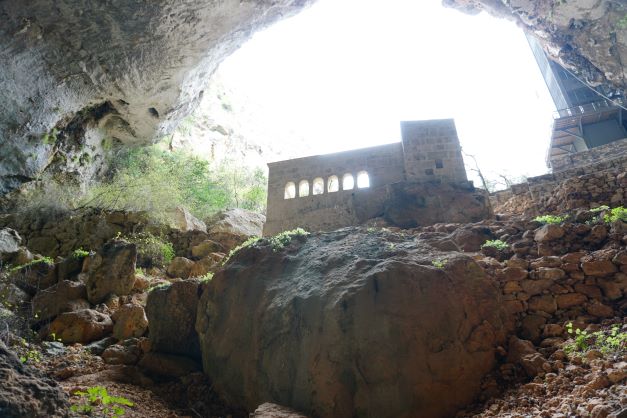
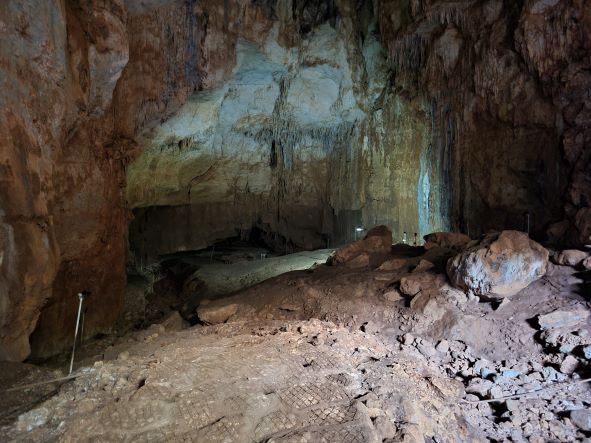
After we passed the church, the sinkhole turned into more of a cave, the steps became slippery due to the moist environment. At or near the end of the cave, you can hear what appears to be water running. This stream forms the Heaven and Hell Cliffs, and it empties into the sea at Narlıkuyu bay, making the water of this bay ice-cold. When looking back toward the entrance, it appears that you are looking up at heaven with the church sitting at the entrance.
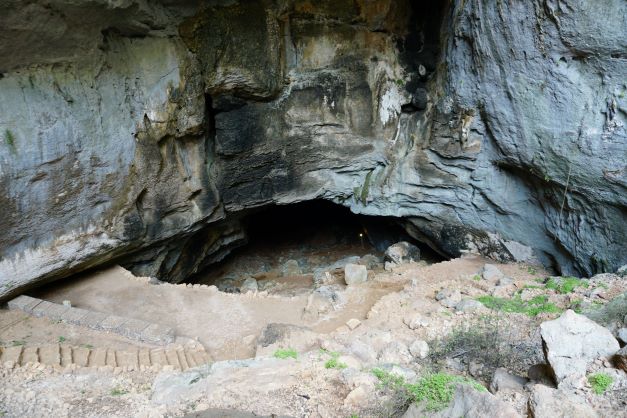
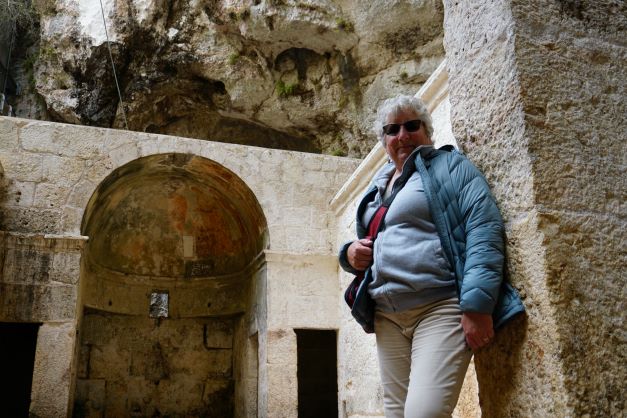
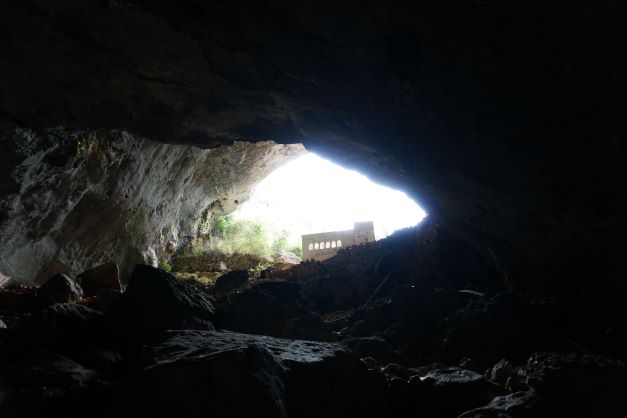
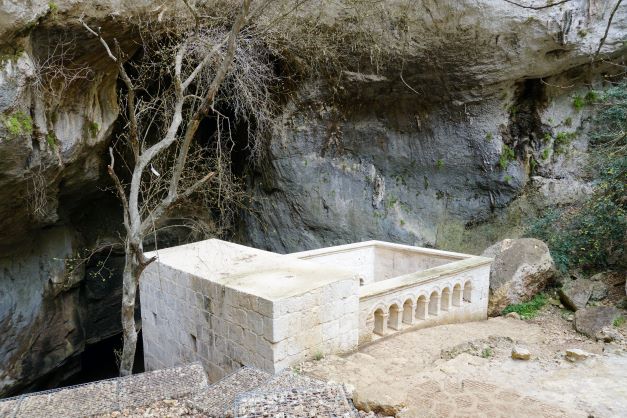

In 2018, an elevator was added to Cennet Sinkhole so that those who are not in good health can get up and down easily. Our advice is to take the stairs going down into Heaven sinkhole this will make the experience more enjoyable.
Sinkhole To Hell
Like the Heaven Sinkhole, the Hell sinkhole was formed due to the collapse of the karst land. It is impossible to descend into the Hell sinkhole; the depth is 128 meters. A glass viewing terrace is located above the hell sinkhole so that you can look straight down into the depth of hell. The platform is safe, but if you are fearful or nervous about heights, my sister would not step out onto it, then enjoy what you can. This new platform is a lot safer than the viewing platform used previously.
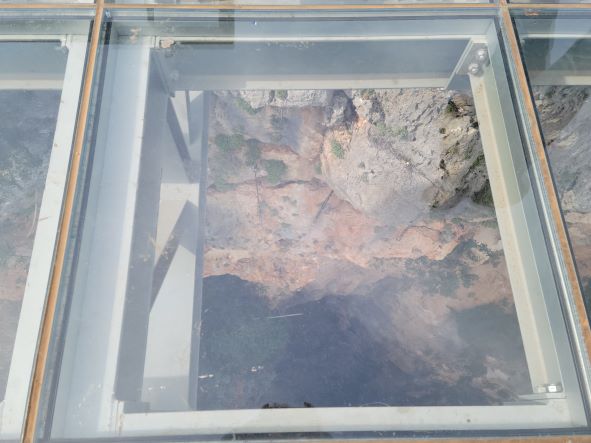
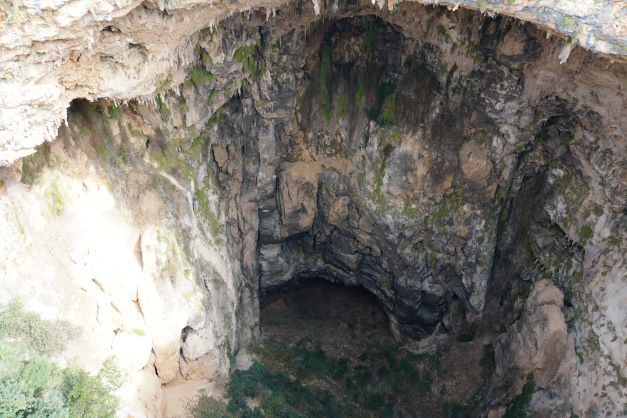
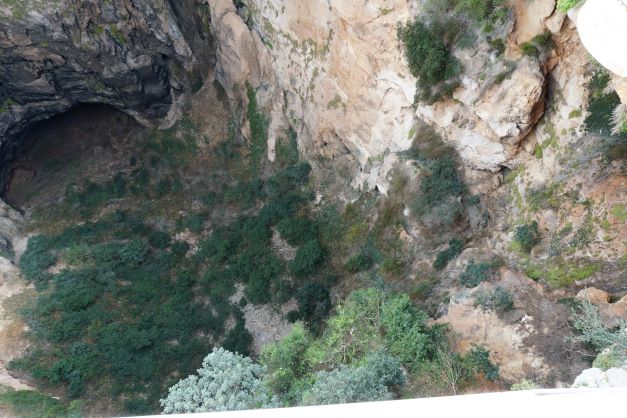

Myth Of Zeus And Typhon
Of course, the two caves figure prominently in ancient Greek myths, according to which Typhon, a fire-breathing 100-headed dragon, battles Zeus, king of the gods. Zeus is defeated and imprisoned in these chasms. Hermes and Pan rescue Zeus, who goes after Typhon again, defeats him, and buries him in the earth, but Typhon’s fire-breath issues from the ground as what we know as Mt Etna, the active volcano in Italy.
How to Go to Heaven and Hell Sinkholes?
Heaven and Hell sinkholes in the direction of the signposts on the Mersin-Antalya highway. It is 3 km west of Kızkalesi. After turning to the right, following the signs from the road (left when coming from the west), it can be reached by going 1.5 km more.
The entrance fee to Heaven and Hell Sinkholes is 45 TL, and the museum card is valid. With the same ticket, you can visit the Astım Cave, which is within walking distance.
There is a WC (bathroom), cafeteria parking, and souvenir shops.
Guide To Kızkalesi Visit Astim Magarasi (Asthma Cave) (map)
Around 1/2km west of the main entrance to the Caves of Heaven and Hell is Asthma Cave, which is said to relieve symptoms of the affliction. It’s worth visiting to see and explore these underworld grottoes, with their staggering limestone formations. The average temperature is 14° C, and the humidity ranges from 85% to 98%, depending on the season (higher in the winter). There’s a cafe-restaurant here, as well as a shop selling souvenirs.
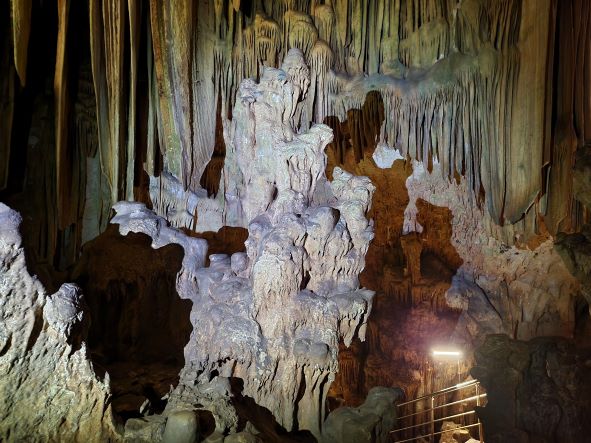
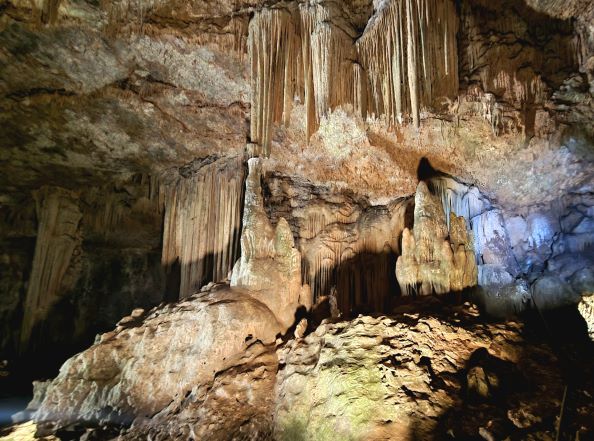
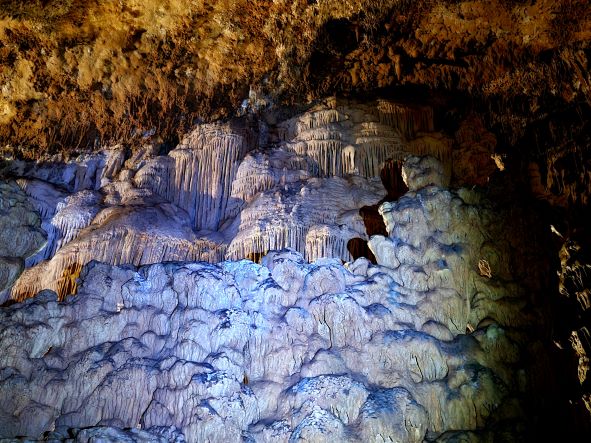

The entrance to the cave is a spiral staircase with 78 steps. When you reach the base, you can feel the cool and humid air as it hits your face and you think you have landed in an alien world. The giant stalactites and stalagmites inside the cave are impressively beautiful. The cave’s depth, which consists of 3 sections, is 15 meters, and its length is 200 meters. Visitors wander around the cave by following a circular path. We enjoyed our short visit here and recommend that you stop and check it out for yourself, especially in the summer heat.
Guide To Kızkalesi Visit Kanlidivane (Kanlı Divane Ören Yeri) (map)
Kanlıdivane is a historical place consisting of many buildings around a sinkhole. The city dates back to the 3rd century. Here, It is possible to see examples of the Hellenistic, Rome, Byzantine, and Ottoman periods.


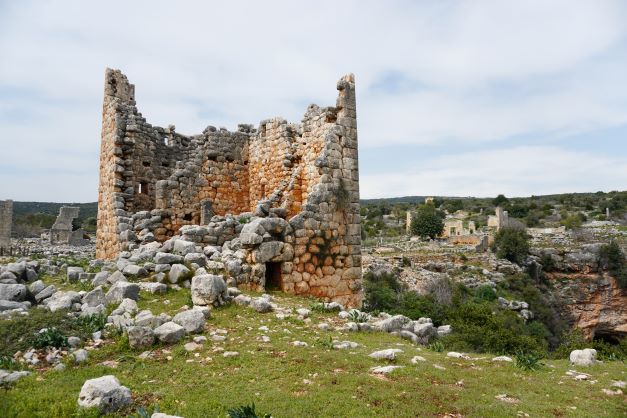
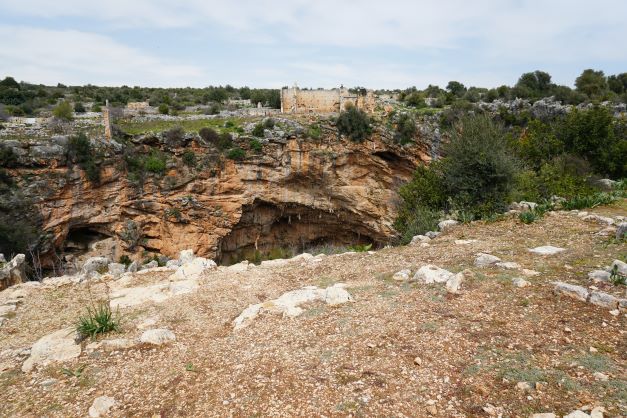
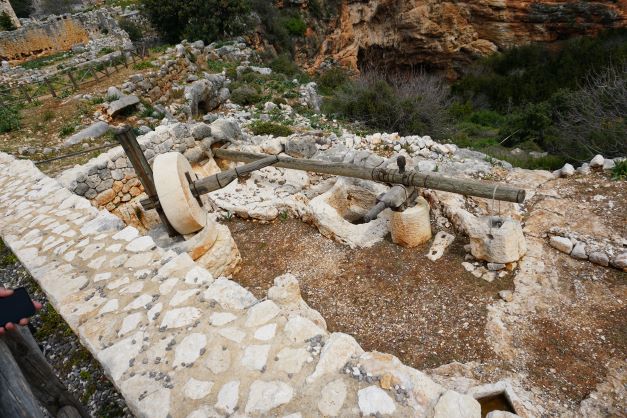
The origin of the name Kanlıdivane (“kanlı” means “bloody” in Turkish). When looking at the source of the name Kanlıdivane, a few stories and rumors are told. The best is “according to the legend; criminals were thrown into the sinkhole and fed to the lions inside. The other was because of the red-stained walls of the pit.
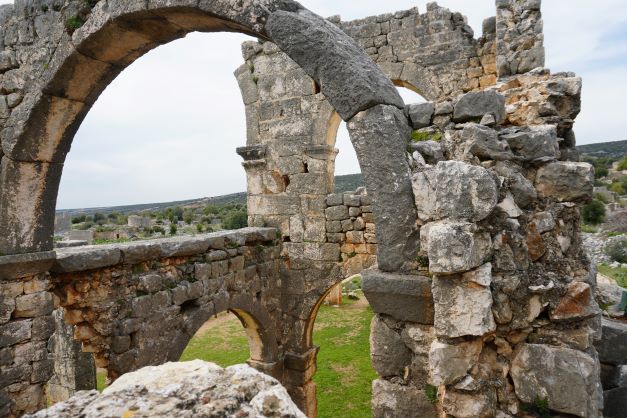
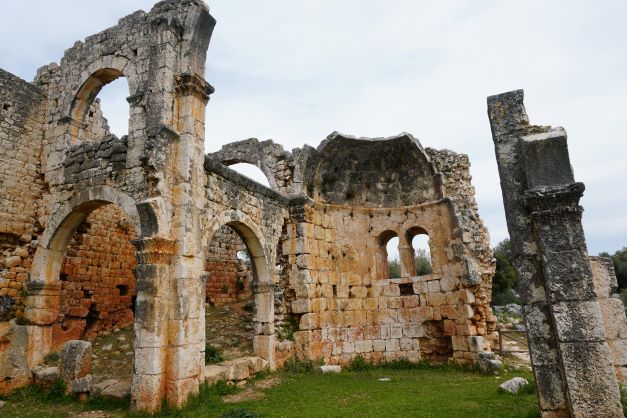
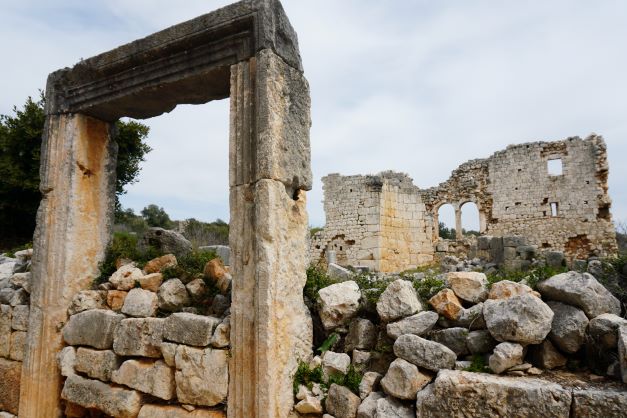

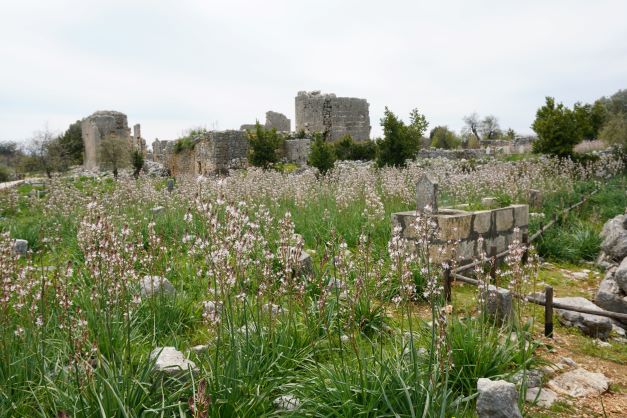
There are many sites to be seen here, from olive processing to churches, houses, and so much more. We enjoyed the visit as it was early spring and flowers were starting to bloom. The flowers added to the beauty of the ruins themselves. There are lots to see and many walking paths that head off in many directions. We spent around 90-minutes between here and the rock tombs close by. We found this a beautiful place to explore and take photographs, a spot that we would recommend as it is only 13 km from Kızkalesi.
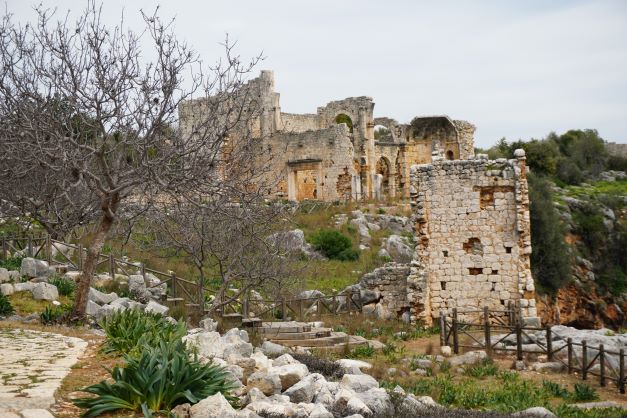

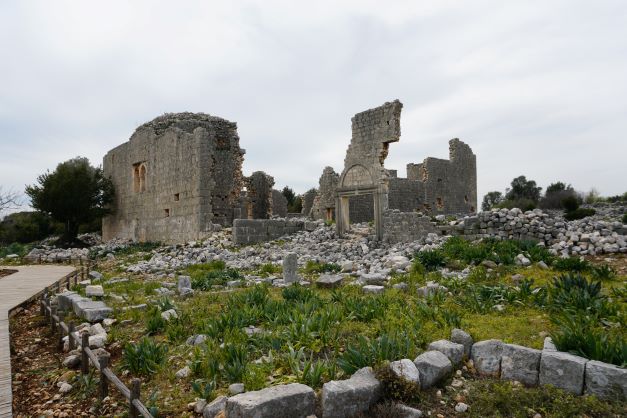
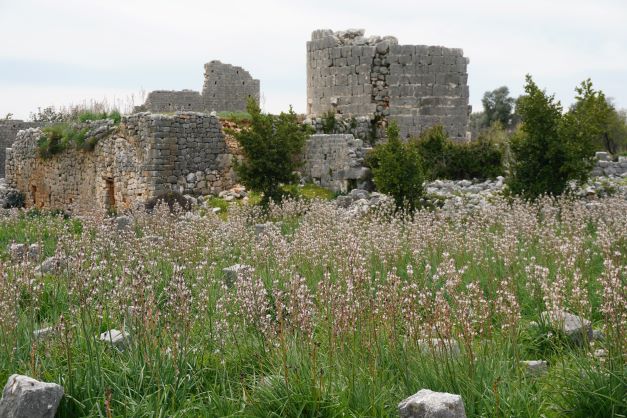
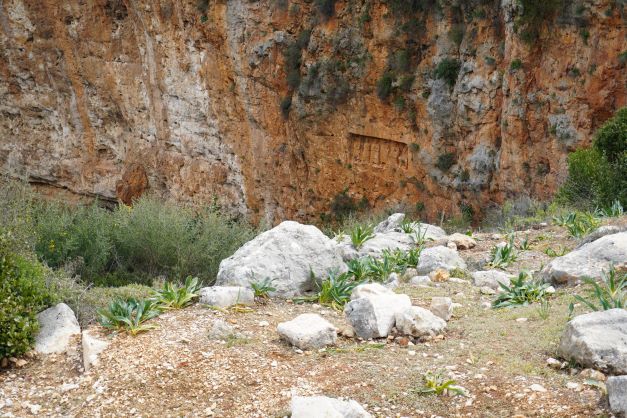
Mourning Woman
There are relief depictions of tomb owners on Çanakçı rock tombs on the rock mass about 1 km southwest of the swallow hole. “The mourning woman” is one of these reliefs. It is dated to the 1st century BC – 1st century AC.
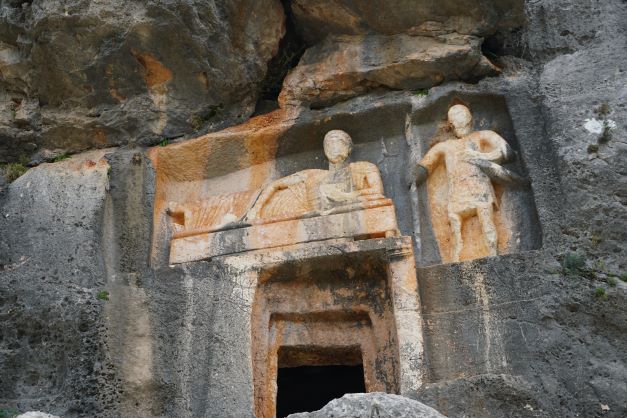


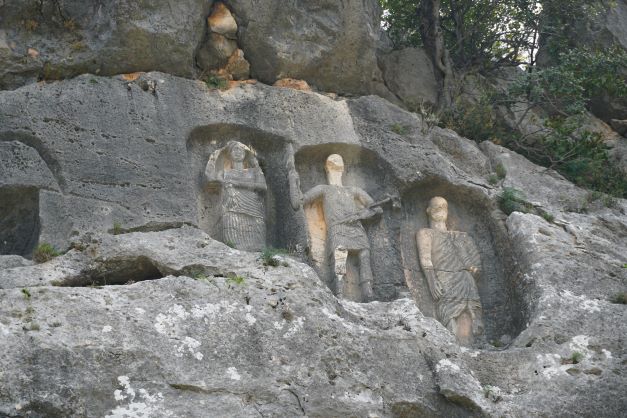
What does it cost to visit Kanlidivane
- The entrance fee is 12.5 TL
Misc. Sights On The Way To Uzuncaburc
On the way to visiting Uzuncaburc, you will see other ruins along the roadway; we stopped at several of these and took pictures; they are stunning and photo-worthy. All the ruins seem to be willy-nilly all over, and most are in excellent shape. Here are some that we found along the road worth stopping at.
Guide To Kızkalesi Visit Uzuncaburc (Dioacaesarea) (map)
Although the history of the ancient city of Uzuncaburç dates back to the Hellenistic period with its 2500-year history, it is thought that Uzuncaburc was considered sacred during the Hittite period. The importance of Uzuncaburc continued during the Roman period with columned streets, a monumental fountain, and entrance gates. The theater of Uzuncaburç had a capacity of 3000 people also built by the Romans. The theater, which is well preserved, has a high capacity for a structure in such a remote location, far from the sea and trade routes. This is a detail that shows how important the city was at that time.
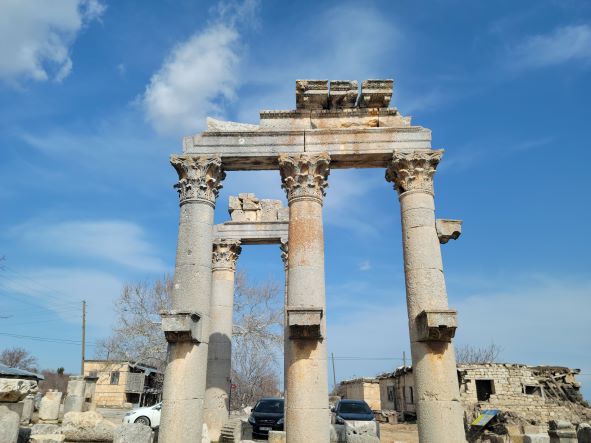
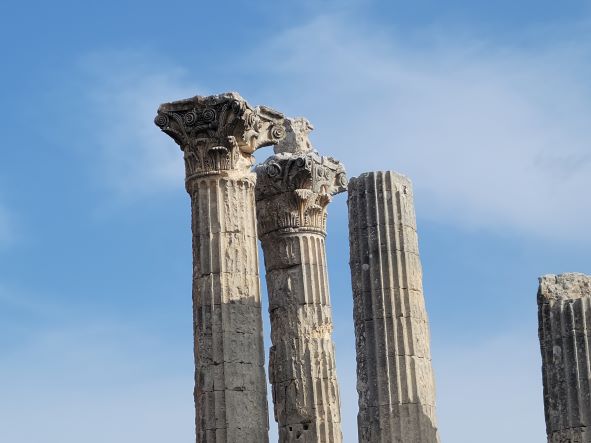

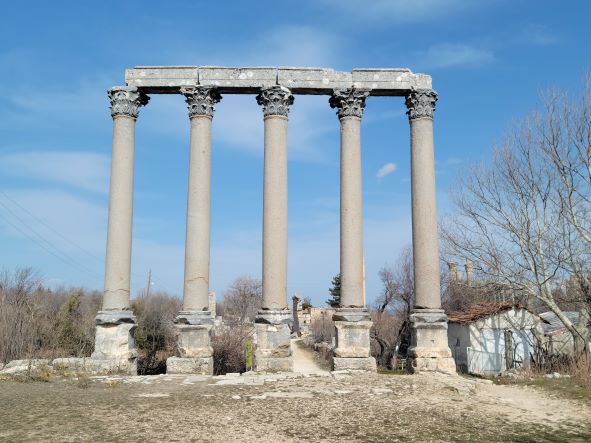
One of the most impressive things to see here is Zeus’s temple as there are so many standing columns found here, We have never seen so many large columns that are still standing. For this reason alone this is worth the visit. It is known that this structure, which is one of the oldest and most magnificent of the Zeus temples, in Anatolia, was built by one of the generals of Alexander the Great. It is thought that the 36 columns around the Temple of Zeus were made of stones that were not found in the region and therefore were brought from far away to make this structure. With the changes made to the temple during the Byzantine period, this place was converted into a church.
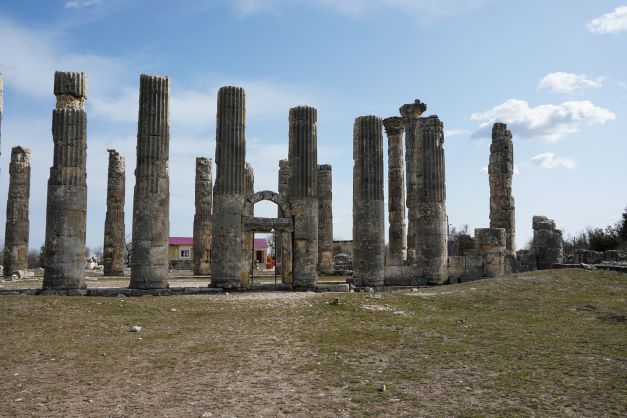

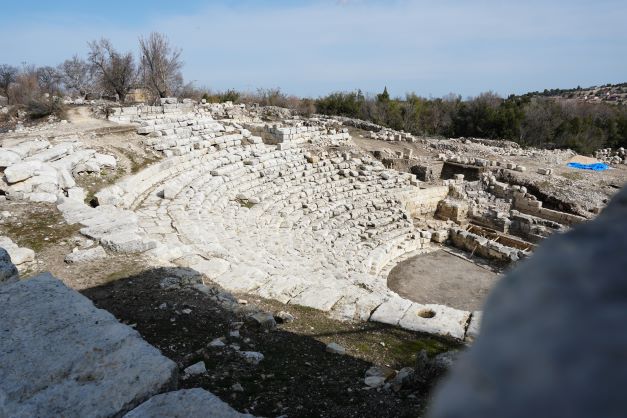

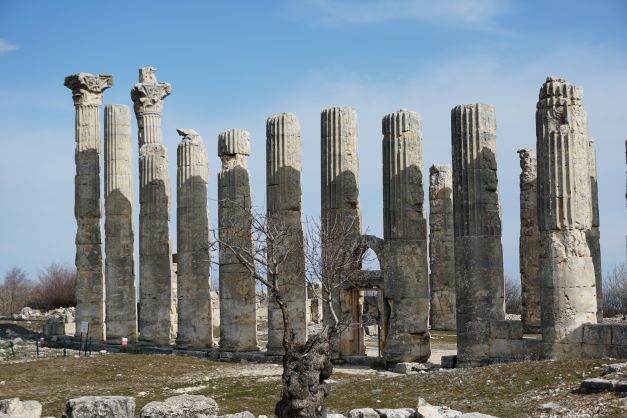
Uzuncaburc is a very well-preserved city of stunning ruins, we spent about an hour here looking around and admiring the beauty of all the ruins. I’ve read that these ruins are going to be restored to what they may have looked like 2000 years ago. With this, in some areas, the access has been gated off so no access is permitted. The theater is behind a fence, but from what you can see it looks impressive. Well worth the drive from Kızkalesi a 30-minute drive. We took lots of pictures while here. We enjoyed our time here and would suggest that if anywhere near here it’s well worth visiting.


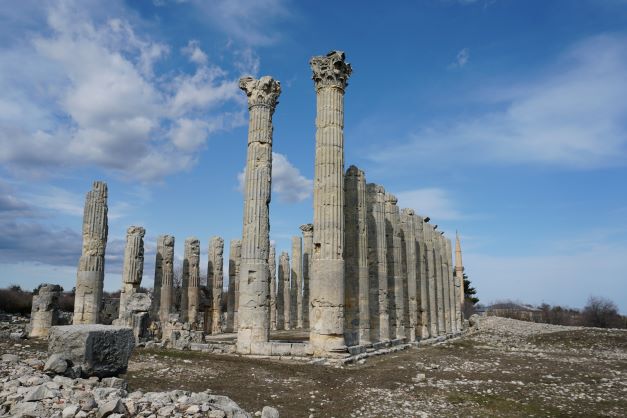

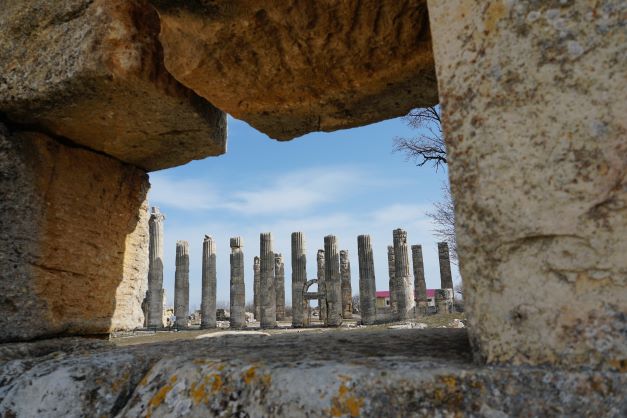
Places to be seen around Kız Kalesi
| Narlıkuyu Museum: 4 km | Hell and Heaven Sinkholes 5 km |
| Asthma Cave: 5 km | Eliaussa Sebaste: 5 km |
| Adamkayalar: 6 km | Kanlıdivane: 12.7 km |
| Cambazlı Church: 20 km | Aşağı Dünya Sinkhole: 21.4 km |
| Kayacı Valley: 23 km | Göksu Delta: 25.1 km |
| Silifke Museum: 25.8 km | Aya Tekla:Temple: 26.3 km |
| Silifke Castle: 27.5 km | Olba Ancient City 28 km |
| Uzuncaburç Ruins: 32 km |
Chronological Timeline Of Turkey
| Paleolithic Age (Early Stone Age) 60,000 – 10,000 BCE | Mesolithic Age (Mid Stone Age) 10,000 – 8,500 BCE |
| Neolithic Age (Late Stone Age) 8,500 – 5,000 BCE | Chalcolithic Age (Copper Age) 5,000 – 3,000 BCE |
| Bronze Age 3,000 – 2,000 BCE | Hatti and Hurrian Civilization 2,500 – 2,000 BCE |
| Troy – II Settlement 2,500 – 2,000 BCE | Hatti and Hittite Principalities Period 2,000 – 1,750 BCE |
| Great Hittite Kingdom Hurri Civilization 1,750 – 1,200 BCE | Troy – VI Civilization 1,800 – 1,275 BCE |
| Aegean Migration and Invasion From Balkans 1,200 BCE | The Anatolian Principalities during the Iron Age 1,200 – 700 BCE |
| Urartu Civilization 900 – 600 BCE | The Civilization of Phrygia 750 – 300 BCE |
| Lydia, Caria and Lycia Civilizations 700 – 300 BCE | Ionian Civilization 1,050 – 300 BCE |
| Persian Conquest 545 – 333 BCE | Hellenistic And Roman Age 333 BCE – 395 |
| The Byzantine Civilization (Eastern Roman Empire) 330 – 1453 | The Seljuk Empire 1071 – 1300 |
| The Ottoman Empire 1299 – 1923 | The Republic of Turkey Since 1923 |
ITT Group Turkey
ITT Group Turkey is a Company that offers exceptional tour packages that can be customized to your specific needs, wants, and expectations. In this series of posts that you will be reading, we have teamed up with the ITT Group Turkey to highlight our travels throughout Turkey. What started out as a search for a transfer from Pamukkale to Fethiye has turned out to be so much more. The ITT Group Turkey pays great detail to customer satisfaction, meaning that they go out of their way to provide a high standard of service for a very competitive rate. ITT Group Turkey can customize a tour package for you, just let them know what you would like to see and do, it’s that easy.
Meral our tour guide for most of our travels would call ahead of our destinations to find restaurants that served a specific dish or find tickets to the Whirling Dervish when we stayed in Konya. My point is that your guide or driver will go out of their way to make your trip one of those life moments that will stay with you forever. All the small details are taken care of just sit back relax and enjoy your private guided tour.
We babyboomerbudgettraveler did not receive any form of compensation, we enjoyed our trip with ITT Group Turkey and would like others to have the same experience. If you follow one of our links to ITT Group Turkey and book using the phrase “3btraveler” you will receive a discount rate of a minimum of 5%.
How To Apply For Turkey eVisa
The Electronic Visa (e-Visa) Application System allows visitors traveling to Türkiye to quickly obtain their e-Visas online (www.evisa.gov.tr) in approximately three minutes. It is possible to obtain e-Visa 7/24 everywhere with an internet connection. After filling in the necessary information concerning their identity, passport, and travel dates, the applicants can obtain their visa and pay the visa fees online. It truly is that easy; We would recommend having a printed copy as well, just because.
Our Thoughts “Guide To Kızkalesi What Sites You Need To Visit”
- Our visit to Kizkalesi was enjoyable, we got to see some of the ruins located in the area. It’s unfortunate that the castle was closed. The restaurants along the beach area were reasonably priced with a good selection and tasty. The beach here looks inviting, it’s too bad our visit wasn’t timed better to enjoy the lovely beach and water.
Our Positives
- We enjoyed visiting the ruins, especially Kanlidivane and Uzuncaburc
- The weather was so much better than what we had left behind in Cappadocia
- Heaven and hell sinkholes were something different to see, and the asthma cave was nice
- The castle out from the beach seems to add to the beauty of the beach
Next Stop
Cindy and I including my sister are off to Gaziantep supposed to be a leading city of gastronomy. The thought of being able to taste the foods of this region excites us as we love to experience new foods and flavors. This is one of the reasons that we purchased this tour that we are on. Meral our tour guide in Pamukkale raved about experiencing the foods from this area, In fact, she said: “if the world was a house Gaziantep would be its kitchen“. Unfortunately, we do not have Meral currently as our guide, we are hopeful that Ugur can step up to show us the kitchen table.
Our next post Guide to eastern turkey uncover its hidden secrets” will cover several stops, Gaziantep, Mardin, Sanliurfa, and Kahta (Mount Nemrut). This will consist of 7 days of touring, eating, and visiting interesting sights.
Support Our Blog And Its Unique Travel Content
You can support our site by using the links through our travel Essential. If you purchase items using our links, we will receive a small commission. There are no extra or hidden costs to you. These commissions assist us in our travel, so we can provide unique content to you through each blog post. If you enjoy our blog and find it interesting and informative please share it with friends. Subscriber, so you never miss a new post. Thank you.
Recommended Travel Essential
Cindy and I call ourselves nomadic, so we use certain essentials to make this way of life easier and more comfortable with our lifestyle. With this in mind, we have composed a list of what we feel are essentials and some tips you might use to plan or take your next travel adventure.
- Travel Packing Essentials to help organize and make this task less stressful
- Travel Safety Essentials to make your life on the road a little safer, giving you peace of mind
- Living essentials to make life a little more comfortable, be this resting, working, or playing.
Accommodation Options While Traveling The World
- Booking.com is one of our go-to’s when we are looking for a place to stay for a couple of days or longer
- Agoda.com we find is best to use when in Southeast Asia, but hey you never know what you might find
- Airbnb.com used to be our go-to but some of their cancelation policies are reasonable, give them a try as well
Travel Insurance
We always travel with travel Insurance, just medical or complete trip coverage. We use Heymondo as we find their costs reasonable. Remember, don’t travel, and without coverage, the savings are not worth the possible costs.
Some links on this page are affiliate links, meaning if you buy a product using our link, we may earn a commission. This commission comes at no additional cost to you. Disclaimer.

